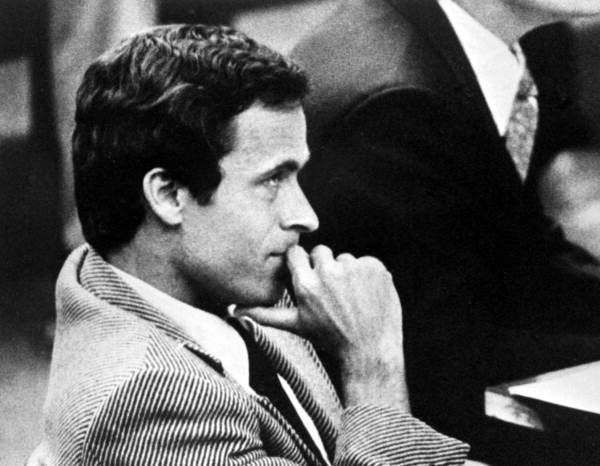Patrolman David Lee with the Pensacola Police Department was conducting his routine patrol in the early morning hours of February 15, 1978, when he just happened to cross paths with Theodore Bundy when he stopped him for a traffic violation. After a slight scuffle in which Bundy tried to flee, Lee managed to handcuff and secure him inside his vehicle. Bundy was quiet for most of the ride, and he knew his criminal adventures were finally over.1 After two successful escapes from jail, there was not going to be an opportunity for another.2
“I wish you had killed me.” He told Lee from the back of the car. “Would you kill me if I tried to run?”3
Before Bundy’s killing spree began, he attended the University of Washington, where he obtained a Bachelors degree and two years of law school.4 Based on the knowledge he gained in law school, Bundy insisted on being directly involved in conducting his defense in each of his trials, which is where his legal downward spiral began. During his sentencing trial, he attempted to connect with his jury and humanize himself by using carefully chosen Bible scripture. He wanted his largely southern jury to see him as comparable to Christ. He assured them that he was no Christ figure, but he urged them to remember how Christ had experienced an unjust trial and was subsequently executed on the basis of that unjust trial.5

As his final trial started to come to its inevitable end, Bundy did everything he could to postpone his execution date. He had multiple interviews with several different individuals; in each interview he would reveal something about himself that he would use to charm or manipulate his audience. One of these interviews led to an examination of evidence to see if Bundy was incompetent at the time of trial, which postponed his sentencing hearing. When a reporter questioned Bundy in an attempt to get him to admit to the thirty suspected murders, Bundy replied, “Put a zero after that.”6 Though we will never be certain on an exact number of murders that Bundy committed, it is without a doubt higher than the thirty that he officially confessed to.

Finally, on January 17, 1989, Bundy’s fourth and final death warrant was signed.7 It was at this point that he started confessing to multiple murders in an attempt to stave off his execution. After having been able to squeeze his way out of nearly every other situation he had managed to entangle himself in, he finally started to realize the inescapable reality, and the mask that he put on to keep the world from seeing him for what he really was, started to slip. He immediately began to look for his way out, trying to tug at the heartstrings of anyone who would listen. His last card to play was his interview with James Dobson.8

Dr. James Dobson is the founder of Focus on the Family, a Christian organization based in Colorado.9 At the time of Bundy’s interview, Dr. Dobson’s campaign was that pornography and violence were interrelated, and since Bundy was looking for a way to keep people talking about him, they were a match made in heaven. Throughout the interview, Dr. Dobson and Bundy were able to craft an entirely new story that thousands of people would believe. Bundy was able to portray himself as being corrupted by pornography from a young age, that pornography is what caused his violent behavior. Dr. Dobson had his perfect poster child. There was a question in the middle of the interview in which Dr. Dobson questioned Bundy about the murder of Kimberly Leach, and Bundy stated that he couldn’t talk about it.
“One of the final murders that you committed, … little Kimberly Leach, 12 years of age. I think the public outcry was greater there because an innocent child was taken from a playground. What did you feel after that? Was there normal emotions three days later? Where were you, Ted?” asked Dr. Dobson.

“I can’t really talk about that,” said Ted Bundy.
“That’s too painful,” Dr. Dobson interjected.
“I would like to be able to convey what that experience is like, but I can’t be able to talk about it,” said Ted Bundy.
“OK,” said Dr. Dobson.10
At this point, the camera caught Bundy’s quick glance at Dr. Dobson, clearly reading and carefully considering his next words. It was at this moment that Bundy’s eyes looked up at Dr. Dobson and in those few seconds his mask slipped, revealing the heartless murderer making his cold calculations on what his next move would be. The facade of the repented sinner that was corrupted by pornography that Bundy had been attempting to convey to us crumbled to reveal the truth, a psychopathic killer.

Throughout the entire forty-minute interview, he carefully chose his words in order to most effectively charm whatever audience he could manage to get his words to. This interview is where we get one of his most infamous quotes:
“And people need to recognize it’s not some kind of . . . those of us who are or who have been so much influenced by violence in the media, in particular, pornographic violence, are not some kind of inherent monsters. We are your sons and we are your husbands, and we grew up in regular families. And pornography can reach out and snatch a kid out of any house today. It snatched me out of my home 20, 30 years ago, and as dedicated as my parents were, and they were diligent in protecting their children and as good a Christian home as we had, and we had a wonderful Christian home, there is no protection against the kind of influences that are loose in society that tolerates. . . .”11
Ann Rule, a former co-worker and friend of Bundy, immediately recognized the interview for what it was: a final attempt to save himself, to blame someone other than himself for what he did.
“Dr. Dobson wanted someone to testify against booze and pornography, and Ted wanted to leave us all talking about him. He wanted to blame someone else for his crimes, and by saying it was us who left all those bad magazines on the racks, he became innocent in his own mind.”12

On January 24, 1989, Theodore Bundy died in the electric chair. As the white flag signaling his death was waved from the prison yard, cheers could be heard from the crowd gathered across the street. The chant “Burn, Bundy, burn!” paired with the banging of frying pans rang out in the early morning air.13
Dr. Dobson did not release the interview until after Bundy was executed. In a way, both of these men achieved their goal. Dr. Dobson had a real-life example of the dangers that pornography can have on a perfectly “normal human.” Bundy was able to keep people talking about him, his horrific murders, and what possible factors led him to commit those crimes. Several women viewed Dr. Dobson’s interview with Bundy and saw the compassion and remorse that Bundy was attempting to portray, while others were able to see through his last lie.14 Bundy went down in history for being one of the most cold blooded killers who will continue to be discussed for generations.
Though many people still protest Bundy’s execution, there is one thing we can all agree on: “He had an easier death than any of his victims.” 13
- George R. Dekle, The Last Murder: The Investigation, Prosecution, and Execution of Ted Bundy: The Investigation, Prosecution, and Execution of Ted Bundy (Santa Barbara, California: Praeger, 2011), 16. ↵
- Kristen Iversen, “When Death Came to Golden,” American Scholar 87, no. 2. (2018): 82. ↵
- George R. Dekle, The Last Murder: The Investigation, Prosecution, and Execution of Ted Bundy: The Investigation, Prosecution, and Execution of Ted Bundy (Santa Barbara, California: Praeger, 2011), 16. ↵
- George R. Dekle, The Last Murder: The Investigation, Prosecution, and Execution of Ted Bundy: The Investigation, Prosecution, and Execution of Ted Bundy (Santa Barbara, California: Praeger, 2011), 22. ↵
- George R. Dekle, The Last Murder: The Investigation, Prosecution, and Execution of Ted Bundy: The Investigation, Prosecution, and Execution of Ted Bundy (Santa Barbara, California: Praeger, 2011), 212. ↵
- George R. Dekle, The Last Murder: The Investigation, Prosecution, and Execution of Ted Bundy: The Investigation, Prosecution, and Execution of Ted Bundy (Santa Barbara, California: Praeger, 2011), 219. ↵
- George R. Dekle, The Last Murder: The Investigation, Prosecution, and Execution of Ted Bundy: The Investigation, Prosecution, and Execution of Ted Bundy (Santa Barbara, California: Praeger, 2011), 218. ↵
- Kristen Iversen, “When Death Came to Golden,” American Scholar 87, no. 2. (2018): 88. ↵
- Dr. James Dobson Steps Down as Focus on the Family Chairman (Colorado Springs, Colorado: Focus on the Family. February 27, 2009), https://www.focusonthefamily.com/about/newsroom/news-releases/20090227-dobson-steps-down-as-focus-chairman. ↵
- The Associated Press,”Bundy’s Last Interview; ‘I take full responsibility,'” The Palm Beach Post, January 29, 1989, 7-8. ↵
- The Associated Press,”Bundy’s Last Interview; ‘I take full responsibility,'” The Palm Beach Post, January 29, 1989, 7-8. ↵
- LAST BUNDY INTERVIEW CALLED `CON GAME,’ Salt Lake City, Utah: Deseret News. September 12, 1989. ↵
- Barry Bearak, “Bundy Electrocuted After Night of Weeping, Praying : 500 Cheer Death of Murderer,” Los Angeles Times, 24 Jan. 1989. ↵
- LAST BUNDY INTERVIEW CALLED `CON GAME,’ Salt Lake City, Utah: Deseret News. September 12, 1989. ↵
- Barry Bearak, “Bundy Electrocuted After Night of Weeping, Praying : 500 Cheer Death of Murderer,” Los Angeles Times, 24 Jan. 1989. ↵



125 comments
Nadia Manitzas
I have heard about Bundy and have even watched documentaries on him and all the terrible things he has done but I had never heard about his interview with Dr. Dobson. Ted Bundy was a intimidating man who had tons of charm. But, because he felt nothing what so ever for the people he killed and the violent acts he committed, the media should not have given him the attention he wanted because that was his goal. He wanted everyone to know he was scared of the punishment he was going to receive despite them knowing of the 30+ victims he had.
Alexandria Wicker
Ted Bundy is a household name in a lot of place. Everybody knows who this man is. I think it is insane how psychotic this man. The fact that he had no remorse for killing over 30 people is quite disturbing. I think it is sad to see himself try and make himself look like the victim. So many innocent lives were taken. This article was very well written and very interesting to read.
Alyssa Ramos
Even many years later, Ted Bundy is still famously known to this day. With a Netflix series and many documentaries about his life and his killings, Ted Bundy definitely achieved his goal of being talked about. Ted Bundy is even talked about in school during Forensic courses. His case is interesting to me because I don’t understand how someone can do such horrific actions over such a long period of time. He manipulated so many by looking and acting like a regular friend, neighbor, and co-worker.
Nicholas Burch
It’s hard to identify the mind of a psychopathic killer since psychopaths can be extremely manipulative. This article did a wonderful job of exposing the impenitent mind of Ted Bundy. It’s crazy how somebody could go from saying “please kill me because now I can’t commit murders anymore”, then, attempting to humanize himself in front of the whole world. Without knowing what he said to the police officer who arrested him for the last time, people could be easily manipulated by his attempts to humanize himself.
Janie Cheverie
This article was very interesting because of the lengths Ted Bundy went through to avoid the death penalty by making himself appear as the victim. This was evident because, on January 17, 1989, he began confessing to multiple murders in an attempt to avoid his execution. The crazy thing about him is that he had no remorse for murdering over 30 people and he was all of the news getting the attention he desired.
Lindsey Ogle
First and foremost, this was a great article that was very well written and easy to follow along. As a forensic science major this article about Ted Bundy immediately caught my eye. I have heard about Bundy and have even watched documentaries on him and all the terrible things he has done but I had never heard about his interview with Dr. Dobson. It was interesting to read about him using his charm, once again to try to get out of the situation he put himself in. It is just crazy how he would never admit to it being his fault and tried to blame everyone else. And I love how you ended the article with “He had an easier death than any of his victims.” it really tied it altogether and made for a great read.
Abilene Solano
I never really learned much about Ted Bundy despite him being one of the most talked about murders in America so reading this article was very interesting! It amazed me how much this man went through just to avoid his impending death penalty and after realizing that he was going to die anyways he decided to set himself up as a victim who went through “unfortunate circumstances”. I could not believe that this man tried everything to make sure that people will continue talking about him even after he is gone (which worked). Also what made my skin crawl is the last line of the article, “there is one thing we can agree on: “He had an easier death than any of his victims” I can’t imagine all the pain and suffering everyone went through because of Bundy, it’s just insane to me.
Aracely Beltran
Great article! I enjoyed learning about it. I just want to know, who brought this serial killer’s case again that they even made a movie about him? I do not think his memory should be kept alive even though learning about court cases is important. It just angers me that women died in the hands of him yet people were defending him at one point because of his “good looks”.
Melanie Fraire
Bundy definitely got his wish, to this day there’s still many and many shows, articles, books, movies, etc. that revolve around his life and the many murders he committed in fact I think he’s without a doubt one of the most popular murderers. However, we can all agree that he was a terrible person yet he’s somehow still glorified and I can’t imagine how the victims’ families must feel being reminded that a loved one of theirs was taken because of some crazy killer and have to constantly see him be talked about.
Mia Hernandez
Having heard about Ted Bundy for many years and watching documentaries about him, it is unbelievable to think about how many people he killed. It is hard to fathom that he was able to commit these crimes by just using his charm and relatively good looks to lore women when they believed they were interacting with a normal person, not a serial killer. After reading this article it reminded me that Bundy was put to death, which many see as being unfair and maybe like he got off easy.